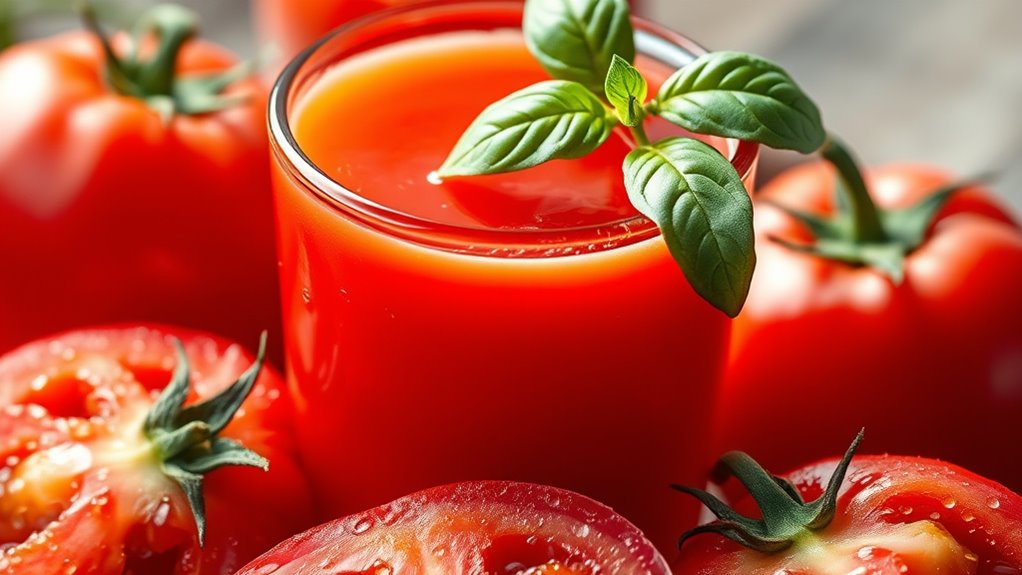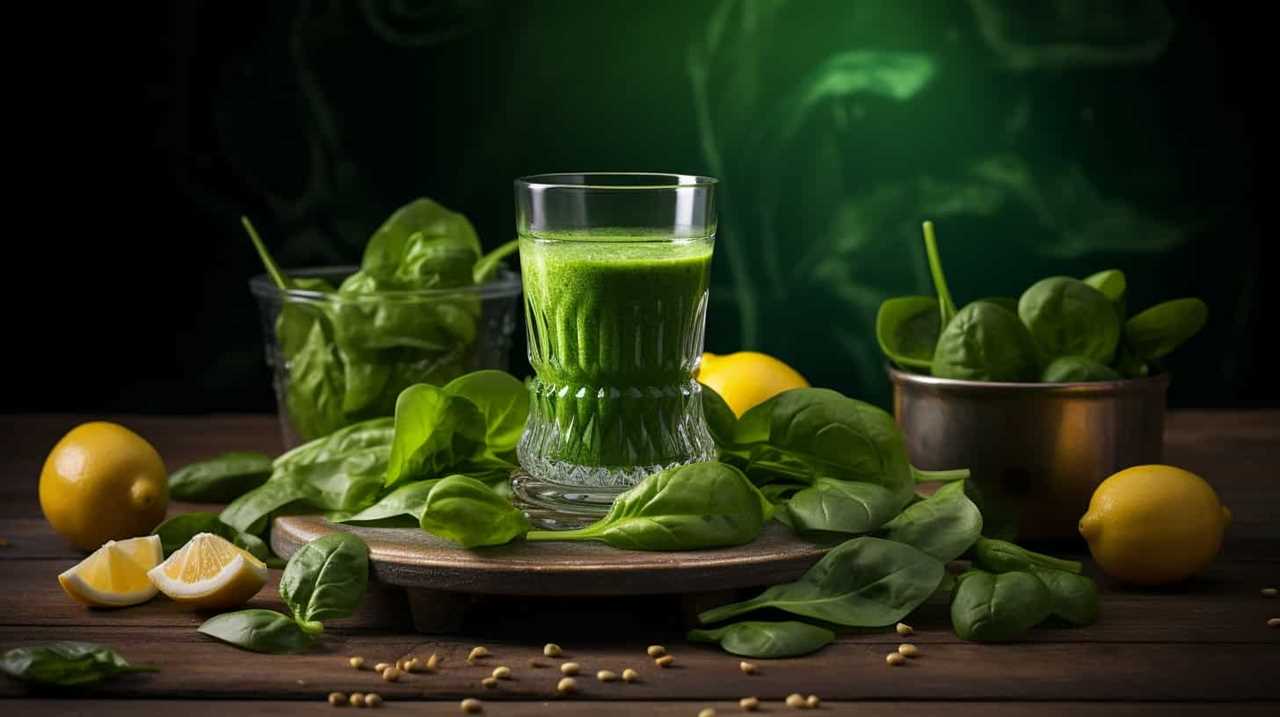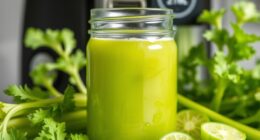To make tomato juice, fresh tomatoes are carefully selected, washed, crushed, and heated to kill bacteria. Advanced processing techniques and pasteurization help preserve nutrients like vitamins C, A, and antioxidants. Proper packaging and storage in cool, dark places extend its shelf life, keeping the juice flavorful and safe for weeks or months. If you want to discover how these processes maximize health benefits and flavor, stay tuned for more insights.
Key Takeaways
- Fresh tomatoes are carefully processed through washing, crushing, heating, and pasteurization to produce safe, nutrient-rich tomato juice.
- Advanced processing and packaging techniques extend shelf life and maintain flavor and nutritional quality.
- Tomato juice is rich in vitamins, antioxidants like lycopene, and supports immune health and disease prevention.
- Proper storage in cool, dark environments preserves nutrients and ensures product safety over weeks or months.
- The combination of careful processing and natural nutrients makes tomato juice a flavorful, healthful beverage option.

Have you ever wondered why tomato juice remains a popular beverage worldwide? It’s because of its invigorating taste, versatility, and impressive health benefits. When you buy a carton of tomato juice, you might not realize how carefully it’s processed to maximize its shelf life and preserve its nutritional benefits. Proper packaging, pasteurization, and storage methods extend the juice’s freshness, allowing you to enjoy it over weeks or even months. This durability makes it easy to keep on hand for quick, nutritious meals or snacks. The longer shelf life doesn’t mean that the juice loses its quality; in fact, manufacturers work hard to guarantee that you get the most out of every bottle.
Tomato juice’s long shelf life results from careful processing and packaging techniques.
Nutritional benefits are a major reason why people reach for tomato juice. It’s packed with essential vitamins and minerals, such as vitamin C, vitamin A, potassium, and antioxidants like lycopene. These nutrients support your immune system, promote healthy skin, and may even reduce the risk of chronic diseases. Drinking tomato juice regularly can help you meet your daily nutritional needs in a simple, delicious way. The natural lycopene content is especially noteworthy because it’s linked to improved heart health and protection against certain types of cancer. Plus, because tomato juice is low in calories but high in flavor, it’s an easy addition to a balanced diet.
The preparation process also plays an indispensable role in maintaining these nutritional benefits. Fresh tomatoes are carefully selected, washed, and crushed before being heated to kill bacteria and extend shelf life. Most commercial tomato juices are then pasteurized, which enhances safety while preserving essential nutrients. This process guarantees that you receive a product that remains safe to consume for an extended period without sacrificing its natural flavors and health advantages. Additionally, advancements in processing techniques ensure that nutrient retention is maximized during production. When stored properly—preferably in a cool, dark place or refrigerated—the juice can retain its freshness and nutritional profile for quite some time.
As a consumer, you benefit from these processes because they guarantee that your tomato juice remains tasty and nutritious until the expiration date. It’s not just about convenience; it’s about enjoying a healthful beverage that supports your well-being. So, next time you pour a glass of tomato juice, remember that behind its vibrant color and savory flavor lies a careful balance of preservation techniques designed to maximize its shelf life and nutritional benefits. That’s what makes tomato juice a timeless favorite worldwide—delicious, nutritious, and reliably fresh for your enjoyment.
Frequently Asked Questions
What Are the Health Benefits of Drinking Tomato Juice Regularly?
Drinking tomato juice regularly boosts your health by providing powerful antioxidant properties that help fight free radicals. It supports your cardiovascular health by reducing blood pressure and lowering cholesterol levels. Plus, it’s rich in vitamins like C and A, which strengthen your immune system. With its savory flavor, tomato juice makes a tasty way to improve overall well-being while enjoying a nutritious, invigorating beverage daily.
How Can I Make Homemade Tomato Juice Without a Juicer?
Making homemade tomato juice without a juicer is like blending a smoothie. You start by chopping ripe tomatoes, then use a blender to puree them until smooth. Next, employ straining methods like a fine mesh sieve or cheesecloth to remove seeds and skin. Pour the strained liquid into a jar, and refrigerate. This simple process gives you fresh, homemade tomato juice without any specialized equipment.
Is Canned Tomato Juice as Nutritious as Fresh?
Canned tomato juice isn’t quite as nutritious as fresh because processing can reduce some vitamins, especially vitamin C. However, it still provides essential nutrients like lycopene, potassium, and antioxidants. When comparing canned versus fresh, fresh tomatoes generally retain more nutrients, but canned juice offers convenience and longer shelf life. To maximize nutrition, choose low-sodium options and look for brands with minimal additives.
What Are the Best Spices to Enhance Tomato Juice Flavor?
You can open the perfect flavor enhancements with just a few spice combinations. Start with a dash of smoked paprika for depth, add a pinch of cayenne for heat, and a sprinkle of basil or oregano for freshness. A touch of black pepper intensifies everything, while a hint of lemon juice brightens the taste. These spices keep your tomato juice exciting, making each sip a flavorful surprise that keeps you coming back for more.
How Long Does Homemade Tomato Juice Last in the Refrigerator?
You can store homemade tomato juice in your refrigerator for up to 3 to 5 days. Be sure to check for spoilage signs like a sour smell, mold, or a slimy texture before drinking. Keep it in a sealed container to maintain freshness. If you’re not planning to consume it within this timeframe, consider freezing it for longer storage. Always trust your senses to detect if it’s still good.
Conclusion
So, next time you enjoy a glass of tomato juice, remember it’s more than just a tasty drink—it’s a health boost packed with antioxidants. Some say it even helps prevent certain cancers, thanks to its lycopene content. While research is ongoing, sipping on freshly made tomato juice can be a delicious way to support your wellness. Give it a try and enjoy the flavor and potential benefits—your body might thank you!















